In the week preceding the 2014 General Election I gave a speech to the AGM of the Council of Social Services in Christchurch. Whenever I’m in Christchurch I feel the spirit of my late brother Laurie O’Reilly, who died in office as the Children’s Commissioner. His mantra was “the primacy of the child” and so I asked myself, what’s the situation now? How are the kids faring?
There is an excellent publication called the Child Poverty Monitor – it’s the result of collaboration between Children’s Commission, Otago University, and the J R Mc Kenzie Trust. It’s grim reading: 285,000 Kiwi kids in families facing income poverty; 180,000 Kiwi kids go without things they need – they face material hardship; 10% of Kiwi kids are in severe poverty and this is persistent poverty that encompasses damp, over crowded houses, not having warm or rain proof clothing, their shoes are worn, many days they go hungry, they don’t get to the doctor when they are sick.
If this is the reality for Kiwi kids in 2014 some sixteen years after the death of Laurie as a kids’ champion I asked the Christchurch audience what was the situation faced by John Key and his mum and two sisters when they moved into 19 Hollyford Ave 45 years ago? What was the reality that young John encountered in terms of the support of the State? What do we need to re-claim from that time? If groups like the Child Action Coalition provide the push for kinder policies then at a community level we need to create pull through community action.
Nicky Wagner came up to me after the presentation and invited me to have a post-election chat with her if she was successful in returning to Parliament. At that time she held the Statistics NZ portfolio and she told me that her Department and Treasury were treating the whole issue of poverty very seriously and were looking for fresh ways to interpret the data they were gathering. I got the sense she liked the cut of my jib, or at least the community action approach I advocate for. I’ll follow up.
Following the Election John Key announced that his Government is determined to do something about those “doing it tough” – the poor.
Across a series of interviews – including an extended (16 minutes) and almost hagiographical session on Campbell Live, and an “Open letter from John Key” in the Herald on Sunday (Sept 26) – Key explained that he considers poverty a long term issue and one that has confronted successive governments. He is anxious about the perverse effects of welfare as regards the ‘trap’ of welfare dependency. He wants to help and also to enable people to help themselves – hand up not hand out.
”We will continue to move people from welfare-based homes to work based homes…we acknowledge that there is potentially more we can do”.
On the other hand he conceded that providing or being in work is not the answer on its own.
As part of my PhD programme I’m attempting to keep a notebook which I regularly submit. Seeing my interest in this issue my lead supervisor Prof Marilyn Waring asked me my opinion of what we might expect from Key and his Government. I offered that there’s something about the Holyoake style: middle of the road, maybe even a slight nod to Bolger’s “decent society”.
On the other hand Key’s underlying ideology is obfuscated by the warm fuzzies and he’s still pressing ahead with FTA’s, less protective workplace conditions, virtual privatisation of social housing and other tenets of the neo-liberal agenda. However I figure in light of the popular mandate Government received we have to work with the hand we are dealt, and I can live with that.
Marilyn asked “do you see how this is all being framed?” Head scratch – “what do you mean?” “Its all being driven downward, its going to be figured in Wellington by officials and policy writers” the sage replied.
We know though both through theory and observed behaviour that change starts at an individual level, at a whanau level, at a community level, and then becomes a broad movement: all elements being intertwined, interdependent, and contemporaneous. You can’t write an edict or construct a policy to compel behaviour change. People choose. Society can help nudge that choice by shrewd application of policies cognisant of behavioural economics or, in the indigenous Maori framework, by the provision of tikanga to steer behaviour through the portals of Te Ao Maori.
I started to mull over the whole issue of poverty – the systemic aspect of a low wage economy and a need to address that. The need for a fresh look at the whole economic landscape is apparent. On the environmental landscape we are trading off our water and replacing it with cow piss. Our choices are presented as ‘either or’ but there has to be some and/and possibilities – a balance between the economy, the environment, and the people who live in it. It requires us to factor in the possibility that people are prone to do the right thing, to take responsibility for self and family, and to work hard for things that implicitly seem to be good, right, and desirable. Understanding and utilising this goodwill requires a relational capacity. This is community sourced and led and is not the consequence of a directive. It requires appreciation of the metaphysical.
I felt drawn to Jimmy Baxter’s Ballad of the Third Boobhead where the third man says
It will take more than talk
to make this a country
where the men who were treated like slaves
work for things other than money
In turn that led me back to Jerusalem Daybook and I reflected on Hemi’s notions of differing types of poverty:
Nga Pohara (the poor: it’s a relative matter; is financial in nature; and, is best addressed through fiscal policy)
Nga Mokai (the fatherless: this is both metaphoric and actual in terms of fatherless families; another form of fatherlessness also applies to the disowned and rejected, the gang members and other difficult to deal with people)
Nga Raukore (the trees who have had their leaves and branches stripped away: these are Hemi’s allusions to the tangata whaiora, addicts and alcoholics, the depressed and alienated, the homeless and lonely
Now its probably accidental, but if you look at these three forms of poverty you could well argue that there is an implicit hierarchy. That in New Zealand a state of material hardship (being pohara) on the part of an individual or family should be able to be addressed if the other two forms of poverty (Nga Mokai, being fatherless and alienated; and, Nga Raukore, being “naked” and alone) have first been addressed or are under control. For instance the Nga Raukore cluster includes those who might be facing mental health issues and their pohara status can be mitigated by professional care and support.
Some Nga Mokai might find their resolution through redefining themselves as fathers rather than as fatherless and behaving in a way consistent with the expectations of being a good father (or child). It is a family construct. Notions such as these are a-rational – based on feelings and beliefs, and sit in the metaphysical sphere. They are in Te Taha Wairua and represent a response to what might be described as a “poverty of spirit”. There are practical programmes of action such as E Tu Whanau
So it seems to me that, ground up, if we are to address poverty, first we need to address poverty of spirit. That’s the poverty that underlies many dysfunctions at a whanau level: the low self-esteem that leads to substance abuse and thence the poor deployment of resources (albeit already meagre) at a household level; and, domestic violence and child abuse.
Before we leave the matter of the 2014 election I just couldn’t get how the Maori voters swung back to Labour instead of supporting the Maori Party and “sitting at the table”. Are they politically naïve or is there something else at play? Do Maori voters not want a Maori body politic? At Parekura Horomia’s tangi John Key commended Parekura for his ‘loyalty’ to Labour. I didn’t understand the basis for this loyalty and went back and re-read Richard Hill, R. (2004) Indigenous Autonomy Crown – Maori Relations in New Zealand Aotearoa 1900-1950. In my view, over time, Labour have given Maori a pretty shitty deal. My conclusion is that at some deep level Labourites are suspicious of Treaty rights, and see them as being counter to Labour’s meritocratic philosophy. Never mind being born with a silver spoon, here in the antipodes it’s the Treaty spoon.
In line with my generally revivalist theme I’ve just come through one big long Labour Weekend at Waiohiki. We called it Revive the Marae. It was an attempt to get our whanau using our marae again regardless of our lack of facilities.
The programme involved a celebration of both life and death: the death side of the equation being that of the unveiling of the headstone of my brother– in- law Tipu Tareha; the life being that of the 21st birthday of my whangai son, Garry Tumana Crawford. It was the completion of two cycles.
Let’s deal with Tipu first. He died on the 20th of June last year following a stroke. Pam found him stretched out in a chair on the deck of his home at the arts village. His brother Hunky (Hugh) and I helped lift him into the ambulance. He was still conscious and aware. I squeezed his hand – “Love you bro”. “I know bro” he said. As a last conversation it doesn’t get better than that.
Tipu’s formal name is Kurupo Te Pakiitu Tareha 3rd. The Tipu bit is short for tipuna, being his illustrious great grandfather Kurupo Tareha 1st. His mum was Hinerau (nee Paetaha – Wainuiarangi [Whanganui]) and his dad Hori Ngakawhe (George) Tareha (Ngati Kahungunu, Ngati Paarau, Ngati Hinewera).
Tipu was one of twelve siblings, and at the age of 56 he has been preceded in death by his sisters Mary Cook [33] and Huia Tareha [38], and his brothers , Rangi (Sky) Tareha [65], and Hori (George) Tareha [64]. This generation of the family have not made old bones. He is survived by his brothers Bunny, Hugh Evan (Hunky), and Jackson, and his sisters, my wife Taape, Te Koha, and Pania.
Tipu was schooled in Taradale. Continuing in the traditions of the Tareha family’s military service Tipu joined the Territorials. He also worked on the chain at Whakatu. When the freezing works closed he became active in the improvements to Waiohiki Marae and worked as the virtual foreman to the late Paris Magdalinos in the reroofing of the whare Te Huinga. He spent time abroad on an extended OE and on return to New Zealand joined the Department of Labour as a GELS officer alongside the late Parekura Horomia. This led Tipu to take up a leadership role on the Waiohiki Conservation Corps in the restoration of Otatara Pa. He maintained an interest in welfare of rangatahi and played a significant role in the Waiohiki Youth Development Programme.

The Waiohiki Conservation Corps and Nanny Millie Hadfield and mokopuna outside the Waiohiki whare iti 1995
In terms of sport Tipu played rugby for the Taradale Rugby Club and, later, became attracted to the harder, faster, game of rugby league playing both for the Pania Panthers, and, then for the champion brothers-like-no-others Taradale Eagles team. He was a very good golfer and was a member of the Napier Golf Club and the Hawke’s Bay Maori Golf Association.
Tipu’s chiefly whakapapa led him to take a role in the local Treaty of Waitangi Claims process including WAI 55, WAI 400, and WAI 168.
Tipu served several terms as Deputy Chair of the Te Whanganui a Orotu (Napier) Taiwhenua and was a Board member of Ngati Kahungunu Iwi Incorporated, a member of the Maori Standing Committees of the Napier City, Hastings District, and Hawke’s Bay Regional Councils, and was the current chair of the HDC Wastewater Committee at the time of his death.
For the five years preceding his death in particular Tipu worked with tangata whaiora in the mental health field, most recently as a member of the Richmond Fellowship. It was a moving moment when at the time of his death some of his clients came to his home at Waiohiki to pay their respects. Their present illness was of no impediment to their obvious sense of connectedness and grief for this man who was not only a caregiver but also a friend.

Reggae legend Tigi Ness and young fans at the tangi, outside Tipu’s home at the Waiohiki Arts Village
Ngati Paarau of Waiohiki hold three traditional tuktuku patterns, being Patikitiki (the flounder) representing generous hospitality; Niho Taniwha (the teeth of the taniwha) representing chiefly bloodlines; and Kaokao (the armpit) representing martial prowess.
Tipu exemplified all three characteristics, being generous and hospitable by nature, carrying a certain gentlemanly noblesse oblige, and, despite his generally loving nature, being a very powerful warrior.
It was this last characteristic, in response to attacks by members of the Mongrel Mob on his whanau and friends, which in 1975 led a youthful Tipu Tareha to become the founding president of the Hawke’s Bay Black Power.
At this time the kaumatua Kurupo Tareha 2nd was still alive. Kurupo 2nd and the kuia Miria (Nanny Millie) Hadfield encouraged the youthful gang members to stay connected with the Waiohiki marae, and gave them practical support and leadership. They were commended for this by a wide spectrum of community leaders including then Prime Minister Rob Muldoon, Dr John Harre, and Maori affairs commentator Professor Ranginui Walker
“The recent convention of Black Power gangs at Waiohiki Marae for instance is a case in point. By inviting them to the marae, responsible Maori leaders were fulfilling a social obligation by integrating these alienated Maori youths into conventional society……Black Power is not, as Pakehas think, the seeds of revolution. If Black Power is pushed into becoming an anti-social force then the adoption of that stance will be due to Pakeha paranoia and not the failure of responsible Maori leadership”
In Nga Tau Tohetohe: The Years of Anger Ranginui Walker 1987: 218
Related events at Waiohiki on Tipu’s watch have also been positively cited by sociologist Dr Jarrod Gilbert in Patched: the history of gangs in NZ 2013)
“Beginning in the 1980’s many chapters of the patched street gangs formed rugby league teams in order to play other chapters of their gang, but within local competitions as well. In Hawke’s Bay the Taradale Black Power chapter formed the backbone of the Taradale Eagles which went on to become the longest ever championship holding team in the history of the Hawke’s Bay Rugby League”.
These were different days than now. The Maori renaissance and Maori tribal development has, in general, become an effective counter to the sense of alienation amongst young Maori that led to the formation of Maori gangs. There is a positive shift, and on that basis it was appropriate that a group of senior leaders from both the Mongrel Mob and the Black Power, from as far afield as Dunedin and North Auckland, came to pay respects to Tipu as he lay in state at Pawhakairo, Waiohiki. They came as a group, together. In an especially poignant demonstration of shared positive purpose, as they approached the whare mate where Tipu lay, the various gang leaders softly, respectfully, and collectively, chanted the Ngati Kahungunu anthem haka ‘Tika Tonu’.
It has been with the encouragement of Ngati Kahungunu leaders such as Tipu’s relation Dr Pita Sharples (and, for that matter Tipu’s mother’s relation Tariana Turia), that what were once viewed as being irreconcilable differences between groups are being put aside in the quest for community wide whanau ora – in the Waiohiki context, as part of Tipu’s moemoea, the building of a new marae facility and a healthy, wealthy, and wise 21st Century kainga.
Indeed in the year since his death part of Tipu’s dream is coming to fruition through the commencement of a papakainga development consisting of eight homes being built on his whanau’s land by Te Ngati Hinewera whanau Trust which Tipu chaired for more than a decade. The papakainga will be an ongoing testament to his leadership.
In the weeks leading up to the unveiling Waiohiki was a hive of activity. Tip’s nephew Maurice and I water blasted the whanau tombs in the urupa, and painted most of them sepulchre white, with the exception of Tareha Te Moananui’s tomb which Maurice decorated in green and gold being the Parliamentary colours.
Life and death are interconnected. Here, we seem to have been in almost permanent tangi mode, and lacking marae facilities for the last decade, apart from burying our dead in the urupa, we have fallen into the habit of going elsewhere to celebrate life events. To the best of my recall I think the last time we had a significant celebration of the living at Waiohiki was my son Tareha’s 21st birthday now some 14 years ago!
It seemed to me that it was time that we revived our practice of use and so I developed a programme of activities for Labour weekend.
Now the bridge from the dead to the living: twenty one years ago my friend and brother Gary Crawford died.
His partner Vicki Moutere was pregnant at the time and at Gary’s graveside I made a solemn promise to care for and protect his unborn child. Some months later his son Garry Tumana Crawford was born. I wrote a charter which I gave to Vicki stating that I would provide this boy with an annual koha on the anniversary of his father’s death and do my best to support him in life. I’ve stayed true to that. Five years ago Garry’s (Tumana) mum Vicki also died. At her tangi I asked the whanau if I could play a role in his education. He was 16 and at high school at the time. He stayed a while with his whanau out at Waimarama and then seeking a tertiary education he came to live with Taape and me at Waiohiki. We adopted him in the Maori tradition of whangai and so he has become our seventh child.
I decide to hold Garry’s 21st on the Saturday, the eve of Tipu’s unveiling, as a celebration of life and as a salute to Tipu and to his brother-in-arms Gary Crawford Snr., and indeed other Eagles’ brothers- like- no- others from Waiohiki who have now passed on as well.
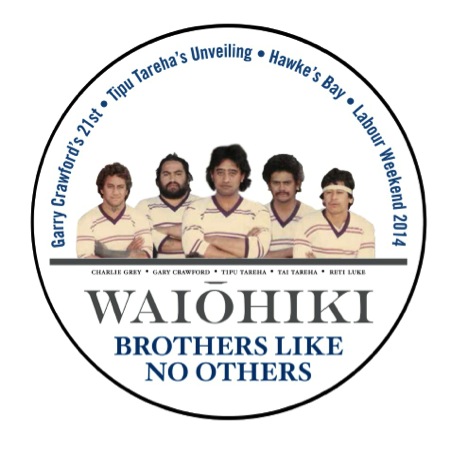 We had a big clean-up at the marae, repaired windows in the shed, set up a temporary kitchen, and erected a large marquee and an inflatable dome.
We had a big clean-up at the marae, repaired windows in the shed, set up a temporary kitchen, and erected a large marquee and an inflatable dome.
Hugh, Tareha, and Garry collaborated in painting up a number of decorative pou, with a contemporary twist and we placed these at strategic points.
On the Saturday chef Dawnie Baker and the back-up team from Waipuka drove the kitchen. The menu was along the lines of Subway with pork, beef, and fish, as the main fillers.
We’d taken a couple of carloads of brothers and whanau up to Te Araroa a couple of weeks beforehand to celebrate Tumanako’s 50th (also scheduled for Labour weekend so we couldn’t attend), drink a bottle of Johnnie Walker Blue that I’d given as a present, and to collect a cattle beast that the East Coast brothers had donated, with the idea of using half for the 21st and half for the unveiling.
It was a sublime trip. After a night of kai and korero, and yes, whisky, the boys killed, skinned, cleaned, and hung the beast, using a well-placed tree and the flow of a frigid breeze until the carcass reached an ambient temperature. In the early evening we were off home. We had the meat in a chiller for a few more days and then off to the butcher where after further hanging it produced 40 kg of mince and about 160 kg of various beef cuts.
Toa and Ash had fattened a pig. We slow roasted that as well as the beef, virtually as pulled pork and pulled beef. Our baker Heinz, from Grains of Europe, made us up around three hundred buns and we treated them like a base for sliders, and also provided hundreds of wraps, salads, and deep fried paua balls. It was a party-food hakari.
There was a big turnout from Waipatu (Garry’s mum and dad had been stalwarts of the Waipatu Catholic Culture Club) and with his classmates from the EIT and local friends we had a big ope at the powhiri and a total of about 250. The night was a boomer. There were the obligatory speeches and waiata, and then Chad Chambers and his band lit up the sounds, followed by Tigi Ness, and then our local group Rude Boyz and the whole pa was skankin’. It was a really good feeling, sensing the strong wairua of Waiohiki, looking out on the maunga Otatara, and celebrating a young man’s passage into adulthood. I felt as if this was one completed stage in my commitment to Garry’s father over 21 years ago.
The following day was sunny and bright. After church we worked hard all morning and into the early afternoon cleaning up in preparation for the unveiling. Again there was a big turnout for Tipu’s day. Lani and members of the HB chapter had worked hard in preparing Tipu’s stone and it looked fantastic
After the powhiri and an opening salvo from the Hamuera Ratana Silver Band and hymns from the choir, Tipu’s cousin, Hoani Hawaikirangi, in his role as apotoro, led the requisite prayers and dedication of the stone. Tip’s friend Nigel Hadfield read the inscription on the front and Tipu’s young soldier nephew, Kohatu Karamu, read the back stone. Ngati Kahungunu chief Ngahiwi Tomoana gave an uplifting speech and there was more waiata from the Waiohiki whanau. It was just beautiful. We may have been in the urupa but the marae was alive.
Back in the day our family in Timaru had a 1958 Morris Isis (Series II). It was sort of the same shape as a Morris Oxford but had a longer wheel base and an extended bonnet to accommodate a great big Woolsey type 6 cylinder overhead valve 2639cc motor producing 90bhp. It had this little short gearstick on the right hand side between seat and door and a four speed synchromesh gearbox. It was a lumbering great thing, over two tonnes in weight, but it could wind up from a relatively slow start to reach 97km per hr in 17.6 secs and then start to almost fly up to a top speed of around 140km. It was the car I was allowed to drive my St Pats First Fifteen team mates because the old man reckoned that the strength of the chassis would keep us all safe if I pranged. My dad knew a thing or two. It must have been 1970. We’d finished our 6th Form year and one night we had a party out past the Levels towards Pleasant Point. On the way home we started racing. I overtook Mc Goldrick’s Mk3 Zodiac at the end of the Pleasant Point Straight, but ran out of room to pull the beast up and rammed the old girl straight into the Washdyke War Memorial at around 120km p/hr. The old man was right and my mate Geoff Mc Cambridge and I survived virtually uninjured. The point of this shaggy dog tale is contemporary geo-political: it may be the first and to date only incidence of an Isis assault on a martial edifice in Aotearoa. Kia tupato. Let’s keep it that way.
In the days ahead at Waiohiki we face a number of challenges. I’ve stepped back to a great deal from day to day operational activity across a broad range of things and the next generation of leaders are making the calls. It’s a warm and heartening feeling to see their demonstrated competence. The young men of the whanau have also been doing a great job preparing the Hinewera site for the eight house “papakainga whanau ora” that is underway. Since our little “hiki tapu” blessing ceremony for the project a month back they’ve generally cleared the decks for action, ripped out 500 ginko, and felled and milled a number of 100 year plus English Elm trees. The wood has fantastic grain and it will be used for the papakainga.
The number and complexity of decisions to be made increases on a weekly basis, but we are making steady headway. The next issue looming for us is the unsatisfactory way in which the local “Mana Ahuriri” Treaty settlements are rolling out, and I’ll share some details about that in our next encounter.
In the meantime, kia hiki te wairua, feed and uplift the spirit. That’s the challenge for Aotearoa in November 2014.
Arohanui. D






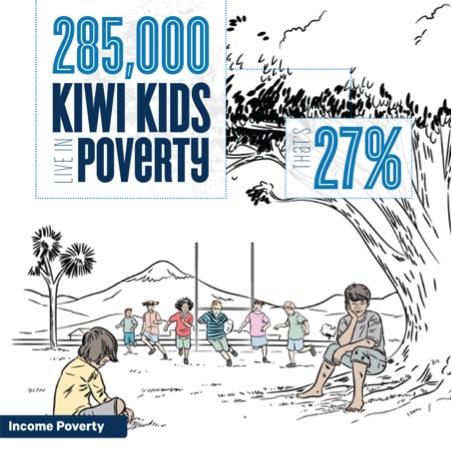




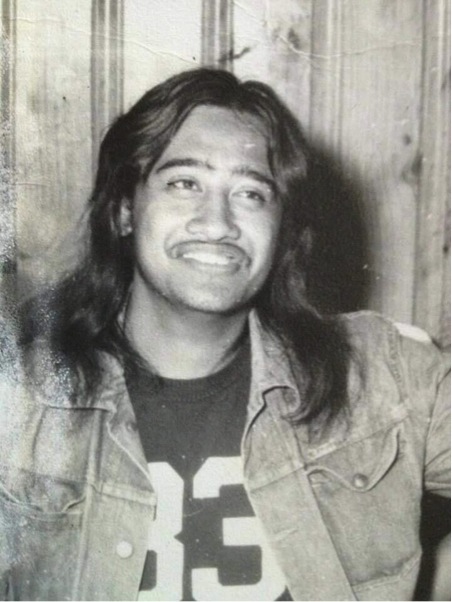




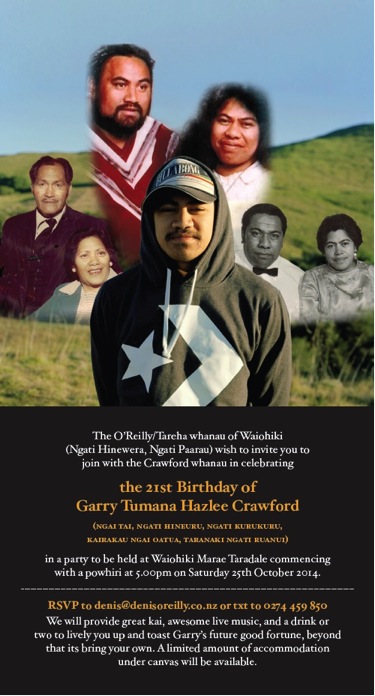






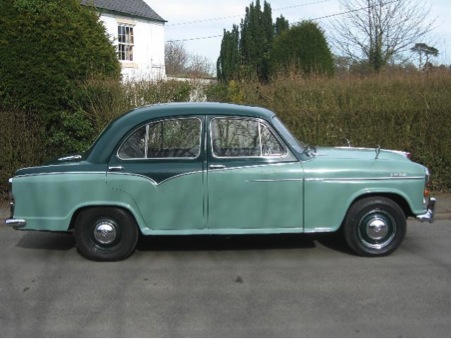


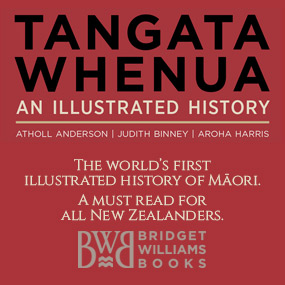














Mihi tino aroha ki a koe e te tuakana.....
Bro that was just beautiful I laughed and cried and felt the love the sorrow and the joy and the greatness of the spirit that is enshrined within the house of Waiohiki the voice heart and soul speak crisp and true you and all of Waiohiki hold a special place in my heart then as now and for always